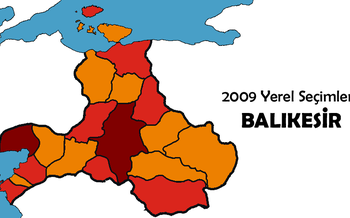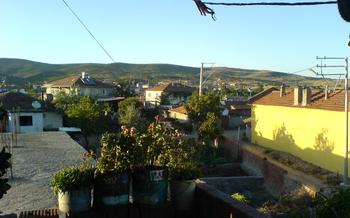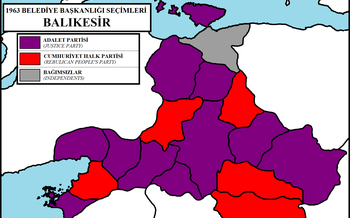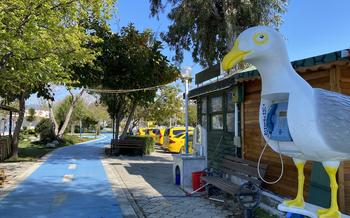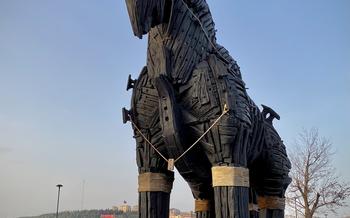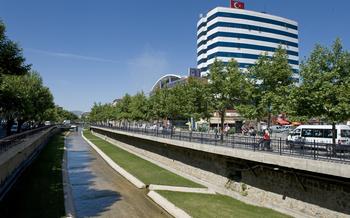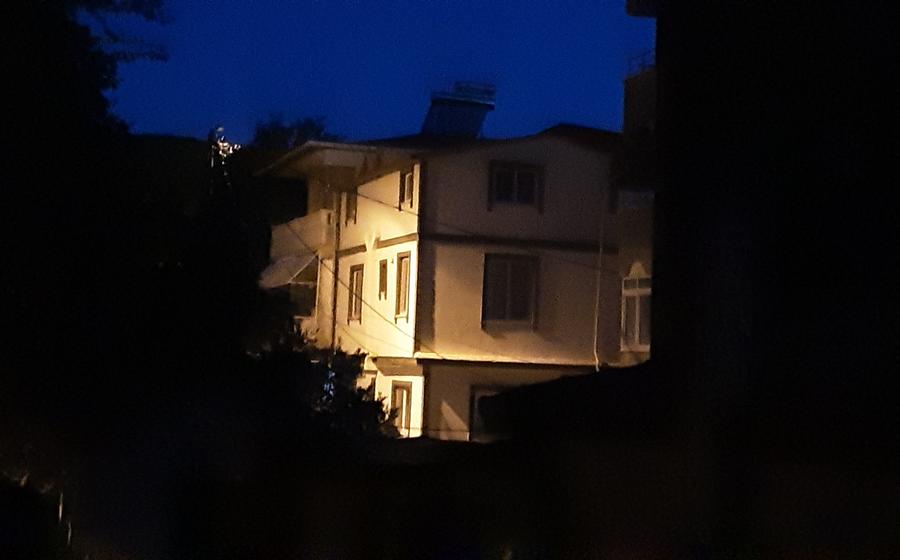
Edremit Olive Oil Museum
- History of Olive Oil Production in Edremit
- Location and Getting There
- Museum Highlights
- Olive Oil Production Process
- Varieties of Olives
- Olive Oil Tasting
- Souvenirs and Local Products
- Educational Programs
- Seasonal Events and Festivals
- Nearby Attractions
- Accessibility for Visitors
- Photography and Social Media
- Sustainability and Conservation
- Local Cuisine and Olive Oil
- Insider Tip
History of Olive Oil Production in Edremit
The history of olive oil production in Edremit dates back to ancient times, with evidence of olive cultivation and oil extraction techniques that can be traced back to the 4th century BC. During the Hellenistic period, Edremit, known as Adramyttium, was an important city-state renowned for its olive oil production. The region's favorable climate, fertile soil, and abundant olive groves contributed to the flourishing of olive cultivation.
The ancient Greeks and Romans used olive oil for various purposes, including cooking, lighting, and religious rituals. They developed sophisticated methods for olive oil extraction, using stone mills and presses to crush the olives and separate the oil from the pulp. These traditional techniques have been passed down through generations and are still used by some local producers today, alongside modern machinery.
Olive oil has played a significant role in the local economy and culture of Edremit throughout history. The region's economy has been closely tied to olive cultivation, with olive oil being one of the main agricultural products. The production and trade of olive oil have contributed to the prosperity of Edremit and have helped shape its cultural identity.
Location and Getting There
The Edremit Olive Oil Museum is conveniently situated in the heart of Edremit, a charming coastal town in the Balıkesir province of Turkey. Its exact address is Cumhuriyet Mahallesi, Atatürk Bulvarı No:78, 10200 Edremit/Balıkesir.
To reach the museum from major cities like Istanbul or Ankara, you can take a bus or rent a car. Buses depart from various terminals and take approximately 5-7 hours to arrive in Edremit. If you prefer a more flexible option, renting a car is recommended. The drive from Istanbul takes about 5 hours via the O-5 and O-3 motorways, while from Ankara, it's a 7-hour journey through the scenic Anatolian countryside.
Once in Edremit, finding the museum is a breeze. It's located on Atatürk Boulevard, a main thoroughfare running through the town center. Parking is readily available in the vicinity, with designated parking lots and street parking options.
Museum Highlights
The Edremit Olive Oil Museum offers a captivating experience that immerses visitors in the world of olive oil production and its significance to the region. Interactive exhibits and displays provide an engaging and educational journey through the history of olive oil making, showcasing ancient techniques and modern innovations.
Interactive Exhibits:
Interactive exhibits allow visitors to explore the various stages of olive oil production, from harvesting and pressing olives to bottling and storing the final product. These exhibits provide hands-on experiences that make learning about olive oil production interactive and memorable.
Olive Oil Tasting Experiences:
One of the highlights of the museum is the opportunity to participate in olive oil tasting experiences. Visitors can sample different varieties of olive oil and learn to distinguish their unique flavors and aromas. Expert guides provide guidance on how to properly taste olive oil and identify its quality characteristics.
Guided Tours:
Guided tours are available in multiple languages, ensuring that visitors from around the world can fully appreciate the museum's exhibits and learn about the significance of olive oil in Edremit. These tours offer a deeper understanding of the olive oil-making process, the history of olive cultivation in the region, and the cultural significance of olive oil in Turkish cuisine.
Olive Oil Production Process
The olive oil production process begins with the harvesting of olives, which takes place between October and December. The olives are picked by hand or using mechanical harvesters and then transported to the mill for processing.
At the mill, the olives are washed to remove any dirt or debris. They are then crushed using a traditional stone mill or a modern steel crusher. The resulting paste is called pomace.
The pomace is then pressed to extract the oil. This can be done using a traditional press or a modern centrifuge. The oil that is extracted is called virgin olive oil.
Virgin olive oil is then filtered to remove any impurities. It can then be bottled and sold as is, or it can be further refined to produce extra virgin olive oil.
Extra virgin olive oil is the highest quality olive oil and has the lowest acidity. It is also the most flavorful and has the most health benefits.
Traditional olive oil production methods are still used in some parts of Edremit. These methods are more labor-intensive, but they produce a higher quality oil.
Modern olive oil production methods are more efficient and cost-effective. They produce a lower quality oil, but it is still a good option for cooking and other purposes.
Olive oil is a healthy fat that is rich in antioxidants. It has been shown to have many health benefits, including reducing the risk of heart disease, stroke, and cancer.
Varieties of Olives
The Edremit region is home to a diverse array of olive varieties, each with its own distinct characteristics and flavors. Among the most notable are:
-
Ayvalık: A small, round olive with a delicate flavor and a high oil content. It is often used in salads, appetizers, and cold dishes.
-
Gemlik: A larger, oval olive with a slightly bitter taste. It is often used in cooking and baking, as well as in the production of olive oil.
-
Domat: A medium-sized olive with a sweet and fruity flavor. It is often used in table olives and olive oil.
-
Memecik: A small, round olive with a mild and nutty flavor. It is often used in salads, appetizers, and cooking.
-
Sarıulak: A large, oval olive with a buttery and rich flavor. It is often used in cooking and baking, as well as in the production of olive oil.
The different varieties of olives are influenced by a number of factors, including the soil, climate, and cultivation practices. The Edremit region's unique microclimate, with its warm summers and mild winters, is ideal for olive cultivation. The region's farmers have also developed centuries of expertise in growing and harvesting olives, which has contributed to the high quality and diversity of the olives produced in Edremit.
Olive Oil Tasting
Olive oil tasting is an essential part of the experience at the Edremit Olive Oil Museum. In the museum's dedicated tasting room, visitors are invited to sample a variety of high-quality olive oils, each with its distinct flavor profile. Expert guides are on hand to provide guidance and explain the sensory characteristics to look for.
Proper olive oil tasting involves using all of your senses. First, observe the oil's appearance. A good-quality olive oil should be clear and free of sediment. Next, take a small sip and aerate it in your mouth. Pay attention to the initial taste, which should be slightly bitter or peppery, and the lingering aftertaste, which should be fruity and harmonious.
Common tasting mistakes to avoid include consuming olive oil on an empty stomach, which can lead to a distorted perception of its flavor, and using plastic cups or utensils, which can affect the taste of the oil. Instead, opt for small glass or ceramic cups and cleanse your palate with unsalted bread or water between samples.
By following these simple guidelines, visitors to the Edremit Olive Oil Museum can fully appreciate the unique flavors and aromas of this liquid gold.
Souvenirs and Local Products
At the Edremit Olive Oil Museum, you can purchase a variety of olive oil-based products, including bottles of fresh olive oil, handmade soaps, and natural cosmetics. These products make for excellent souvenirs and gifts for friends and family.
By purchasing directly from the museum, you are not only supporting local businesses and farmers but also contributing to the preservation of traditional olive oil production techniques.
When selecting olive oil, look for bottles that display the harvest date and a seal of quality from a reputable organization. Avoid bottles that are exposed to direct sunlight or heat, as this can affect the oil's flavor and nutritional properties.
Educational Programs
The Edremit Olive Oil Museum offers a wide range of educational programs to promote olive oil knowledge and appreciation. These programs cater to various audiences, including students, researchers, and the general public.
Workshops and Seminars: The museum regularly conducts workshops and seminars on olive oil production, tasting, and health benefits. These interactive sessions provide participants with hands-on experience and in-depth knowledge about olive oil. Experts from the field share their insights, allowing attendees to gain valuable insights into the world of olive oil.
Opportunities for Students and Researchers: The museum offers opportunities for students and researchers to conduct research on various aspects of olive oil. Collaborations with universities and research institutions are encouraged, providing students with a unique platform to explore their interests in olive oil science and technology. Access to the museum's resources, such as the library and laboratory, further enhances the research experience.
Preserving Olive Oil Traditions: The museum plays a crucial role in preserving and promoting the traditional knowledge and practices associated with olive oil production in Edremit. Through educational programs, the museum ensures that the younger generation understands and appreciates the cultural heritage of olive oil. Workshops on traditional olive oil extraction methods, for example, provide a glimpse into the rich history of olive oil in the region.
Seasonal Events and Festivals
Olive Harvest Festival Edremit comes alive each year with the annual olive harvest festival, a celebration of the region's rich olive oil heritage. Held during the autumn months, the festival showcases the age-old traditions of olive cultivation and production. Visitors can witness the bustling atmosphere of the harvest, with farmers tending to their olive groves and collecting the precious fruits of their labor.
Cooking Demonstrations and Cultural Performances The festival offers a delightful array of cooking demonstrations, where local chefs share their culinary secrets using the finest Edremit olive oil. Participants can learn to prepare traditional dishes that highlight the unique flavors of the region's olive oil. The festival also features vibrant cultural performances, including traditional music, dances, and storytelling.
Dates and Highlights of Upcoming Events The olive harvest festival typically takes place in October or November, coinciding with the peak harvest season. Visitors are encouraged to check the museum's website or social media pages for the exact dates and program highlights. This year's festival promises to be even more spectacular, with exciting new events and activities in store.
Nearby Attractions
The Edremit Olive Oil Museum is part of a vibrant cultural and historical tapestry in Balıkesir. Visitors can delve deeper into the region's heritage by exploring nearby attractions that showcase Edremit's unique identity. The Kazdağları National Park, just a short drive away, offers breathtaking landscapes, hiking trails, and pristine forests. The ancient city of Assos, known for its well-preserved theater, is another must-visit destination, providing a glimpse into the area's rich past.
For those seeking a refreshing coastal escape, the beaches of Altınkum and Çamlık are just a stone's throw away, inviting visitors to bask in the sun, swim in the azure waters, and indulge in water sports. Edremit is also renowned for its vibrant nightlife, with a variety of bars and restaurants lining the picturesque waterfront.
When planning your itinerary, consider dedicating a day or two to explore the surrounding region. A suggested itinerary could include a morning visit to the Olive Oil Museum, followed by an afternoon hike in Kazdağları National Park. On another day, embark on a boat tour to explore the stunning coastline, and in the evening, savor the local cuisine at one of Edremit's charming restaurants.
Whether you're a history buff, nature enthusiast, or simply seeking relaxation, Edremit and its surroundings offer an abundance of attractions to satisfy every traveler's desire. Immerse yourself in the region's rich tapestry of culture, history, and natural beauty, and create lasting memories that will stay with you long after your visit.
Accessibility for Visitors
The Edremit Olive Oil Museum welcomes visitors from all backgrounds and abilities. The museum is fully accessible to visitors with disabilities, featuring ramps, elevators, and accessible restrooms. Multilingual guides and materials are available upon request, ensuring that everyone can learn about the fascinating world of olive oil in their preferred language. To ensure a seamless and enjoyable visit, it is advisable to inform the museum staff in advance if you have any specific accessibility requirements. The staff is dedicated to providing assistance and making necessary arrangements to accommodate your needs. Take advantage of this opportunity to immerse yourself in the rich history and traditions of olive oil production, regardless of your physical abilities.
Photography and Social Media
Photography enthusiasts and social media mavens are welcome to capture their Edremit Olive Oil Museum experience and share it with the world. However, we kindly ask that you respect the museum's guidelines to ensure a pleasant and enjoyable visit for everyone.
Responsible Photography:
- Please be mindful of other visitors and avoid blocking exhibits or causing disruptions while taking photos.
- Use flash photography only when permitted and avoid disturbing delicate artifacts.
- Refrain from using tripods or selfie sticks inside the museum to prevent accidents or damage.
Social Media Sharing:
- Share your museum experiences, photos, and insights on social media platforms using the hashtag #EdremitOliveOilMuseum.
- Tag the museum's official social media accounts (@EdremitOliveOilMuseum) to connect with our community and be featured.
- Encourage your followers to discover the rich history and significance of olive oil in Edremit.
Online Communities:
- Join the global olive oil community by connecting with like-minded enthusiasts online.
- Participate in discussions, share knowledge, and explore the diverse world of olive oil.
- Discover new trends, recipes, and events related to olive oil culture.
Remember, your photos and experiences can help promote the museum and Edremit as a vibrant destination for olive oil enthusiasts worldwide. Let's create a vibrant online community that celebrates the passion for this liquid gold!
Sustainability and Conservation
The Edremit Olive Oil Museum is deeply committed to promoting sustainable practices and raising awareness about the importance of environmental conservation. Through its various initiatives and educational programs, the museum strives to minimize its ecological footprint and inspire visitors to adopt eco-friendly habits.
One of the key aspects of the museum's sustainability efforts is the promotion of organic olive oil production. By working closely with local farmers and cooperatives, the museum encourages the adoption of organic farming techniques that protect the environment and enhance the quality of olives. Organic farming practices, such as crop rotation, natural pest control, and the use of organic fertilizers, help maintain the health of the soil, reduce pollution, and preserve biodiversity.
Moreover, the museum actively reduces waste and promotes recycling. Visitors are encouraged to bring their own water bottles and use reusable shopping bags to minimize plastic waste. The museum also collaborates with local recycling organizations to ensure that waste is properly disposed of and recycled.
To further educate visitors about sustainability, the museum offers educational programs and workshops on various topics related to olive oil production and conservation. These programs cover topics such as organic farming, sustainable harvesting techniques, and the importance of biodiversity in olive groves. Through these initiatives, the museum empowers visitors to make informed choices and contribute to a more sustainable olive oil industry.
Visitors can actively contribute to conservation efforts by supporting local farmers and cooperatives that prioritize sustainable practices. By purchasing organic olive oil and other local products, visitors directly support the livelihoods of local producers and encourage them to continue their sustainable practices. Making eco-friendly choices, such as reducing single-use plastics and conserving water, also helps protect the environment and promote a more sustainable future for olive oil production in Edremit.
Local Cuisine and Olive Oil
Olive oil is not just a culinary staple in Edremit; it's an integral part of the local culture and gastronomy. The rich, fruity flavors of Edremit olive oil elevate simple dishes to culinary masterpieces. Traditional cuisine here revolves around fresh, seasonal ingredients, with olive oil playing a starring role. From hearty soups and stews to mezzes and salads, olive oil adds a touch of magic to every meal.
Olive oil is also a key ingredient in many local sweets and pastries. Baklava, a flaky filo pastry filled with chopped nuts and sweetened with honey, is a beloved dessert that wouldn't be the same without a drizzle of olive oil. Another popular treat is zeytinyağlı kurabiye, a buttery cookie infused with olive oil and often flavored with citrus zest or nuts.
For an authentic taste of Edremit cuisine, visit one of the many local restaurants that specialize in traditional dishes. Ask for recommendations from your hotel concierge or a local resident. Some must-try dishes include zeytinyağlı yaprak sarma (stuffed vine leaves), zeytinyağlı enginar (artichokes cooked in olive oil), and balık zeytinyağlı (fish cooked in olive oil).
Whether you're a foodie, a culinary enthusiast, or simply someone who appreciates good food, Edremit's olive oil-infused cuisine is sure to tantalize your taste buds and leave you craving more.
Insider Tip
For an unforgettable experience, make sure to visit the museum's secret olive grove, located just behind the main building. Here, you can wander among ancient olive trees and soak in the tranquility of nature. Capture unique photo opportunities against the backdrop of these majestic trees, their gnarled trunks and silvery leaves creating a stunning visual.
Venture beyond the museum grounds to uncover hidden gems in Edremit. Ask a local about "Liman Lokantası," a hidden gem of a restaurant tucked away in a charming alleyway. Savor authentic Turkish cuisine infused with the region's finest olive oil, creating a culinary experience that will tantalize your taste buds.
To truly immerse yourself in the olive oil culture, plan your visit during the annual olive harvest festival. Held in November, this vibrant celebration showcases the region's rich olive oil heritage. Witness traditional olive picking demonstrations, indulge in delectable olive oil-based dishes, and join in the lively festivities that bring the community together.
